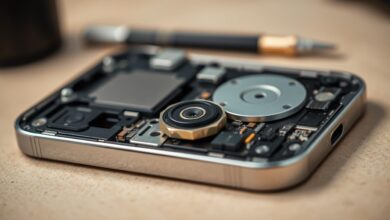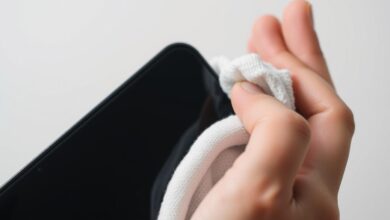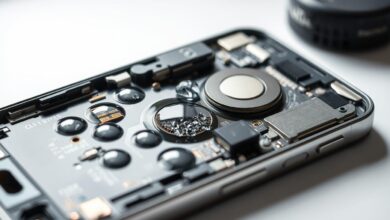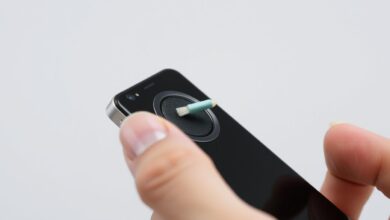how to get water out of a phone
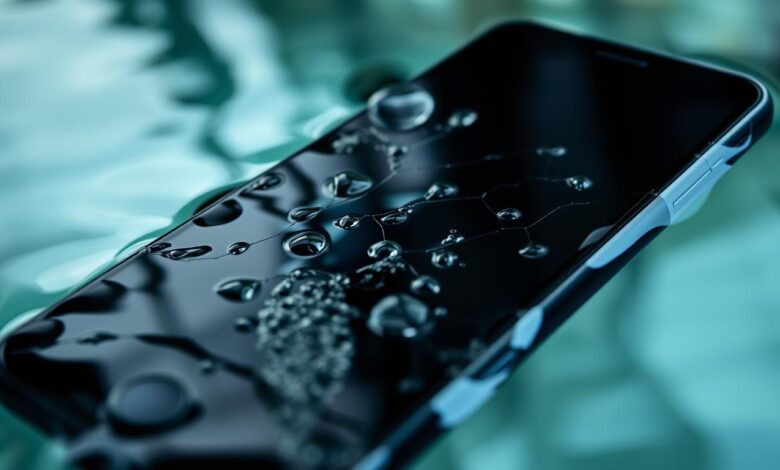
Getting your phone wet can be a big problem. It might happen when you accidentally drop it in the pool or spill something on it. Phone water damage is a common issue many people deal with.
I’ll show you how to save your phone from water damage. With the right steps, you can stop more damage and maybe even save your phone.
This guide will teach you the best ways to dry out your device.
Key Takeaways
- Immediate actions to take when your phone gets wet
- Methods to dry out your phone effectively
- Tips to prevent further water damage
- Signs that indicate your phone needs professional help
- Precautions to avoid common mistakes
The Critical First 60 Seconds After Water Exposure
When your phone gets wet, time is of the essence. The first 60 seconds are key. Quick action can greatly reduce damage risk. It’s vital to act fast when your phone meets water.
Immediate Power Down Protocol
Turning off your phone is the first step to prevent damage. This is true for both iOS and Android devices. It stops short circuits that could harm your phone.
For iPhones and iOS Devices
To power down an iPhone, press and hold the sleep/wake button. Wait for the “slide to power off” slider to appear. Then, slide it to the right. If your phone won’t respond, force restart it by pressing volume up, then volume down, and hold the side button until the Apple logo shows.
For Android and Other Smartphones
For most Android devices, press and hold the power button. Wait for the power menu to appear, then choose “Power off.” If it’s unresponsive, force restart by holding the power button and a volume button at the same time.
Removing External Components Safely
Removing parts can help lessen damage. This includes taking out the SIM card, memory card, and removing the case and screen protector.
SIM Card and Memory Card Extraction
Remove the SIM card and memory card carefully. This stops water from getting in further. Use a paper clip or the tool provided to eject the SIM card tray.
Case and Screen Protector Removal
Take off any case or screen protector to help your phone dry faster. Be careful not to push water into the device.
| Action | iOS Devices | Android Devices |
|---|---|---|
| Power Down | Press and hold sleep/wake button | Press and hold power button |
| Force Restart | Volume up, volume down, then side button | Power button + volume button |
| SIM Card Removal | Use a paper clip or provided tool to eject SIM card tray | |
By following these steps, you can greatly improve your phone’s chances of recovery after water damage. Quick and correct action in the first 60 seconds is key for a successful wet phone fix.
Understanding Water Damage in Modern Smartphones
Water damage can be a big problem for smartphones. It’s important to know how it harms the inside parts. Modern phones have tiny circuits and parts that can easily get damaged by water.
How Water Affects Internal Circuits and Components
Water getting into a phone can lead to short circuits and harm to the inside parts. The delicate circuitry inside is very sensitive. Water can rust metals and ruin the phone’s electronics. Knowing this helps in fixing and restoring the phone.
Corrosion Timeline: What Happens Inside Your Device
Corrosion in a water-damaged phone can start in just hours. At first, water might cause quick short circuits. But, the damage from corrosion can be severe over time. The speed of corrosion depends on how much water the phone got and what kind of water it was.
Water Resistance Ratings Explained (IP67 vs IP68)
Many phones today have water resistance ratings like IP67 or IP68. These ratings show how well a phone can handle water. IP67 phones can usually stay underwater up to 1 meter for 30 minutes. IP68 phones can handle deeper water for longer.
But, these ratings don’t mean a phone is completely safe from water damage. The real performance can vary. Knowing the difference between these ratings helps you understand what your phone can handle.
Understanding water resistance ratings helps you make better choices for your phone. Knowing how water damage affects your phone and what you can do to protect it is key. This way, you can keep your device safe from accidents.
Essential Tools for Phone Water Extraction
To dry out a phone, you need the right tools. These range from simple household items to specialized drying equipment. The success of phone water removal depends on the tools and techniques used.
Household Items You’ll Need Immediately
When your phone gets wet, some household items can help. You’ll need:
- Towels or soft cloths for gently wiping the exterior
- Silica gel packets if available, to absorb moisture
- A bowl or container to hold desiccants or uncooked rice
These items can start the drying process. But, it’s important to know their limits.
Professional Tools Worth Investing In
For better water damage repair, professional tools are worth it. These include:
Moisture Indicators and Testers
Moisture indicators help check water damage levels. Professionals use them to see how much water has gotten in.
Specialized Drying Equipment
Specialized drying equipment, like desiccant dehumidifiers, speeds up drying. These tools remove moisture better than household items.
Using the right tools, both household and professional, can help dry out your phone. It’s all about being ready with the essential tools.
The Rice Method: Separating Fact from Fiction
Fixing a wet phone is a big challenge, and using rice is a common solution. People think rice can soak up water, saving your phone. But does it really work?
Scientific Evidence Behind the Rice Technique
Studies show mixed results on rice’s effectiveness. Some say it can dry out a wet phone by absorbing moisture. But, there’s not much scientific proof it’s a reliable fix for water damage. It’s based on the idea that dry rice can pull moisture from a wet phone.
Proper Implementation for Maximum Effectiveness
To use rice right, put your phone in a container of dry rice. Make sure it’s fully covered. Then, seal the container to keep it dry. Leave your phone in the rice for at least 48 hours.
But, turn off your phone right away after it gets wet. Don’t turn it on until it’s completely dry.
Limitations and Potential Risks
While rice might help, it’s not without risks. Rice dust can get into your phone and cause more harm. It also doesn’t fix corrosion or short circuits from water damage. For a wet phone fix, think about these risks and other drying methods.
In short, rice can be a DIY fix for a wet phone, but it’s not always effective. Use it with caution.
Superior Alternatives to Rice for Water Removal
If you need to dry out your phone fast, there are better options than rice. Rice can soak up moisture, but it’s not the best for drying phones. Experts suggest using other desiccants that work better.
Silica Gel Packets: The Professional’s Choice
Silica gel packets are top picks for drying phones because they soak up moisture well. They help control humidity and are great at drying out phones. But, make sure they’re clean to work well.
Molecular Sieves and Their Effectiveness
Molecular sieves are also great for drying phones. They trap moisture at a molecular level, making them very good for drying small phone parts. Plus, you can heat them up to reuse them, saving money in the long run.
Commercial Desiccants and Dehumidifiers
Commercial desiccants and dehumidifiers are also good for drying phones. Desiccants come in bags or packets that can be placed near your phone. Dehumidifiers remove moisture from the air, helping your phone dry faster.
Comparing Absorption Rates
| Desiccant Type | Absorption Rate (g/g) | Reusability |
|---|---|---|
| Silica Gel | 0.3-0.5 | No |
| Molecular Sieves | 0.2-0.3 | Yes |
| Commercial Desiccants | 0.4-0.6 | Varies |
Cost vs. Effectiveness Analysis
When picking a desiccant, think about cost and how well it works. Silica gel packets are good but not reusable and can cost more over time. Molecular sieves are more expensive upfront but can be reused, saving money. Commercial desiccants vary, so check reviews to find the best one for your phone.
In summary, while rice can dry out phones, there are better options like silica gel packets, molecular sieves, and commercial desiccants. Knowing their absorption rates and costs helps you choose the best method for drying your phone.
Step-by-Step: How to Get Water Out of a Phone Properly
Getting water out of your phone quickly is key. You need to know the steps to save it. The process is detailed, but with the right steps, you can try to save your phone.
Initial Assessment of Water Damage Severity
First, check how much water your phone got. Look for signs like corrosion or moisture. This helps decide what to do next.
Also, figure out what kind of water your phone got wet in. Freshwater, saltwater, and dirty water need different fixes.
Disassembly Techniques (If Applicable)
If your phone can be taken apart, do it carefully. This helps dry it better. But be careful not to damage it more.
iPhone Disassembly Considerations
iPhone users need special tools to safely take it apart. Make sure to follow the right guide for your model to avoid harm.
Android Disassembly Variations
Android phones are different, so disassembling them varies. Check your phone’s manual or online for safe disassembly steps.
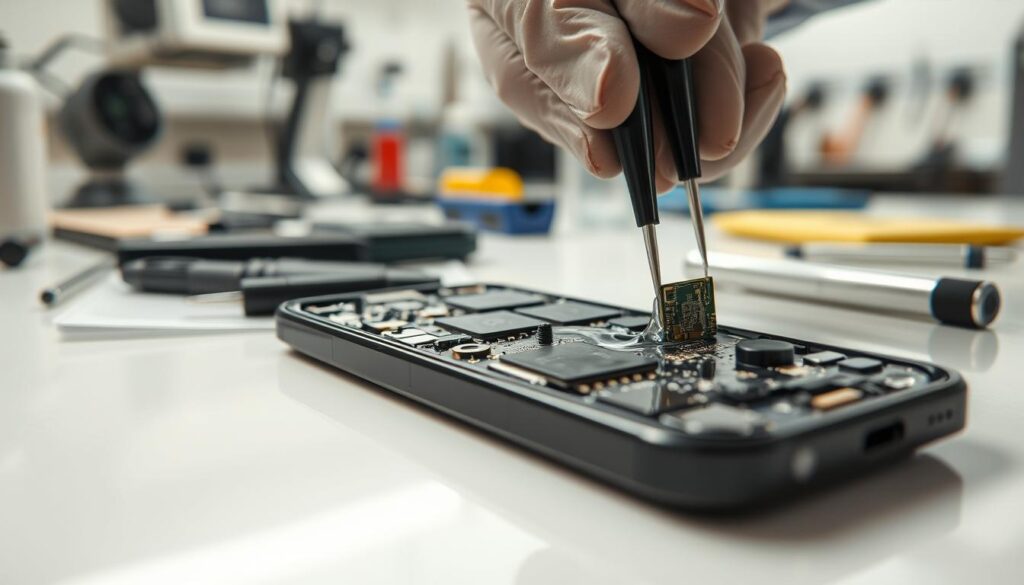
Targeted Drying Methods by Component
Each part of your phone needs a special drying method. Use silica gel for the inside, and other parts might need different care.
| Component | Drying Method |
|---|---|
| Internal Circuitry | Silica Gel or Desiccants |
| Screen | Air Dry or Professional Repair |
| Battery | Immediate Replacement if Damaged |
Reassembly Precautions and Testing
When you’ve dried everything, put your phone back together carefully. Then, test it to see if it works right.
As PhoneArena says, “The key to saving a water-damaged phone is quick and effective drying.”
By following these steps and knowing your phone’s needs, you can try to save it from water damage.
Specialized Approaches for Different Water Types
Water can harm your phone in different ways, depending on its type. This includes freshwater, saltwater, or contaminated liquids. Knowing these differences is key to fixing your phone after it gets wet.
Freshwater vs. Saltwater Exposure Protocols
Freshwater is less damaging than saltwater to your phone’s electronics. But, you must act fast. For freshwater exposure, dry the outside gently and turn off your phone. For saltwater exposure, rinse with freshwater to remove salt, then dry it. Saltwater can cause corrosion, so quick action is important for a wet phone fix.
Chlorinated Pool Water Treatment
Chlorinated water is very corrosive. If your phone got wet in a pool, rinse it with freshwater to remove chlorine. Then, dry it well. This step helps prevent long-term damage.
Toilet Water and Contaminated Liquids
Water from toilets or contaminated liquids is risky because of bacteria and other harmful substances. First, rinse your phone with distilled water. Then, dry it well. Sanitizing your phone is also very important.
Sanitization Procedures
Sanitizing is crucial for phones exposed to contaminated water. Use a soft cloth and mild cleaners to remove any residue. Stay away from harsh chemicals that could harm your phone’s parts.
Additional Cleaning Requirements
Depending on how contaminated the water is, you might need to clean more. This could mean taking apart your phone and cleaning each part. It’s a careful process to avoid more damage.
In summary, the type of water your phone is exposed to greatly affects how you should repair it. By understanding the specific challenges of each water type, you can take the right steps to minimize damage and possibly save your phone.
Common Mistakes That Cause Further Damage
Knowing what not to do when your phone gets wet can help save it. The first instinct to dry a wet phone can actually harm it more.
Heat Sources to Avoid at All Costs
One big mistake is using heat to dry a phone. It might seem like a good idea to use heat to dry it out. But, it can really damage the phone’s inside parts.
Hair Dryers and Their Dangers
Using a hair dryer on your phone is a bad idea. It can push water deeper into the phone and hurt the circuits. The fast heat can also cause water to turn into steam, which is bad for your phone.
Microwaves and Ovens (Never Do This!)
Putting your phone in a microwave or oven is very dangerous. Microwaves can make water inside the phone heat up too fast, causing steam damage. Ovens can also cause overheating, which might start a fire or explosion.
Charging Before Complete Drying
Another big mistake is trying to charge a phone before it’s dry. Charging a wet phone can short circuit and damage it more. Make sure your phone is dry before you charge it. For more tips on fixing a wet phone, check out this guide.
Excessive Movement During the Drying Process
Shaking your phone too much to get rid of water can also hurt it. This can knock loose parts and push water deeper into the phone, making things worse.
Avoiding these mistakes can help save your phone from water damage. It’s important to be gentle and use the right drying methods to get the best results.
Using Isopropyl Alcohol for Corrosion Prevention
To fix a wet phone, using isopropyl alcohol is very helpful. It’s great for stopping corrosion by getting rid of moisture. When used right, it makes water-damaged parts last longer and work better.
Selecting the Right Concentration
The right amount of isopropyl alcohol matters a lot. A 90% or higher concentration is best for fixing electronics. This strong mix makes sure moisture is gone without leaving harmful residue.
Application Techniques for Different Components
Each part needs its own way to use isopropyl alcohol. For example, circuit boards can soak in it to clean off corrosion. But, be careful with speakers and batteries. Too much alcohol can hurt their inside parts.
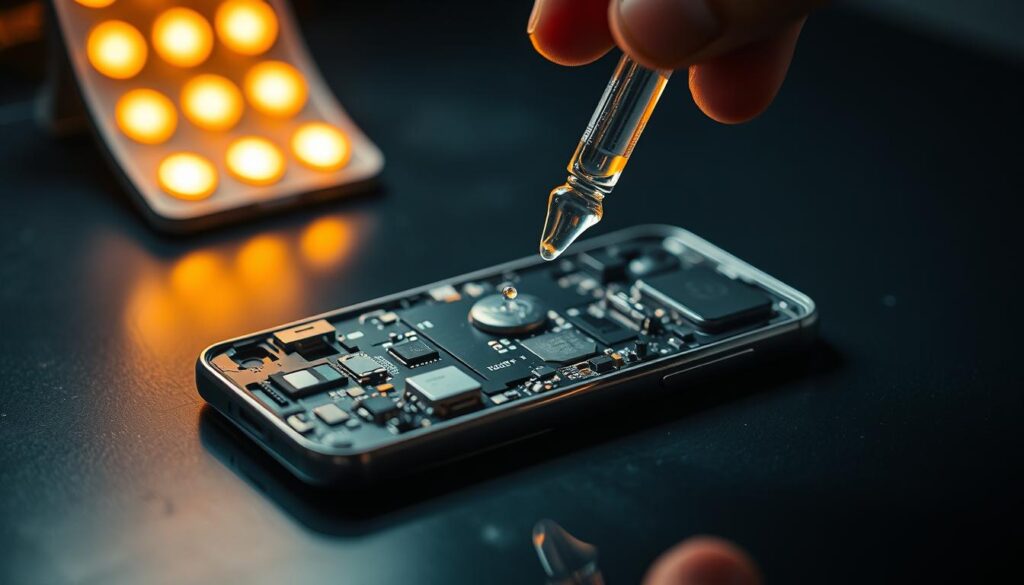
Safety Precautions and Ventilation Requirements
Working with isopropyl alcohol needs good air flow to avoid breathing in fumes. Wear gloves and eye protection to keep skin and eyes safe. Also, remember it’s flammable, so keep it away from heat.
| Component | Application Technique | Safety Precaution |
|---|---|---|
| Circuit Boards | Submersion | Ensure thorough drying |
| Speakers | Light spraying | Avoid excessive exposure |
| Batteries | Minimal contact | Prevent liquid ingress |
Knowing how to use isopropyl alcohol can really help fix water-damaged phones. It’s a key part of fixing them, along with other methods. This way, you can make your phone work like new again and avoid damage in the future.
Professional Water Damage Repair Services
Not all water damage can be fixed by yourself. Knowing when to call for professional help is key. If your phone gets wet, acting fast is important. But sometimes, you need experts to fix it fully.
When DIY Methods Aren’t Enough: Warning Signs
Some signs show your phone needs a pro. Look out for problems like buttons not working or a messed-up screen. Also, if you see corrosion inside or your phone keeps turning off, it’s time to seek help.
Selecting a Reputable Repair Service
Finding a good repair service is crucial. Look for ones with a solid water damage repair history. Check if they know your phone’s brand and model. Also, read reviews and see if they offer a repair warranty.
Questions to Ask Before Handing Over Your Device
- What is the diagnostic process, and is it free?
- What is the estimated cost and timeframe for repairs?
- Do you offer a warranty on your repairs?
Red Flags to Watch For
Watch out for services with bad reviews or no clear costs. Also, avoid those without a warranty. For reliable fixes, check out a professional water damage repair service.
Expected Costs and Timeframes by Damage Level
The cost and time for water damage repair change with the damage level. Small problems might be fixed fast and cheap. But big damage can take longer and cost more.
Testing Your Phone After Water Extraction
Testing your phone after water extraction is key to making sure it works right. After drying your phone, a detailed check is important. It helps spot any problems early.
Systematic Functional Checks to Perform
To check if your phone is okay, do the following:
- Turn on the device and watch how it acts.
- Look for any damage or corrosion signs.
- Test the touchscreen to see if it’s working well.
Audio and Speaker Testing
To check if your phone’s sound works, do this:
- Play music or a video to test the sound.
- Make a call to check the earpiece and microphone.
Camera and Sensor Verification
Test the camera and sensors by:
- Taking photos in different lights.
- Seeing if the proximity sensor and other features work right.
Signs of Residual Water Damage to Monitor
Watch for signs of water damage, like:
- Corrosion on the SIM card slot or other parts.
- Water spots or condensation under the screen.
Diagnostic Apps Worth Using
Use diagnostic apps to check your phone’s health. Look for apps that test hardware and performance.
By following these steps, you can fully test your phone after water damage. This helps find any problems that need more attention.
Long-Term Effects of Water Exposure
When your phone gets wet, the damage might not show right away. Even if you get the water out, there can be lasting effects. These can change how your device works.
Delayed Corrosion Issues to Watch For
Corrosion is a big worry after water damage. Moisture can slowly damage the inside parts. Regular checks help spot problems early.
Battery Performance Concerns and Solutions
Water can hurt your phone’s battery. Corrosion on the battery can make it last less. Keeping an eye on your battery and maybe replacing it can help.
Monitoring for Future Problems
Watch your phone closely after it gets wet. Performance issues can show hidden problems.
Performance Degradation Patterns
Look out for signs like slow charging, less battery life, or shutdowns. Spotting these early can help fix problems.
When to Consider Replacement
If your phone keeps having problems, it might be time for a new one. Think about the cost of fixing it versus getting a new one.
| Issue | Symptoms | Action |
|---|---|---|
| Corrosion | Visible rust, device malfunction | Professional repair or replacement |
| Battery Degradation | Shorter battery life, slow charging | Battery replacement |
| Performance Issues | Slow performance, frequent crashes | Diagnostic check, potential replacement |
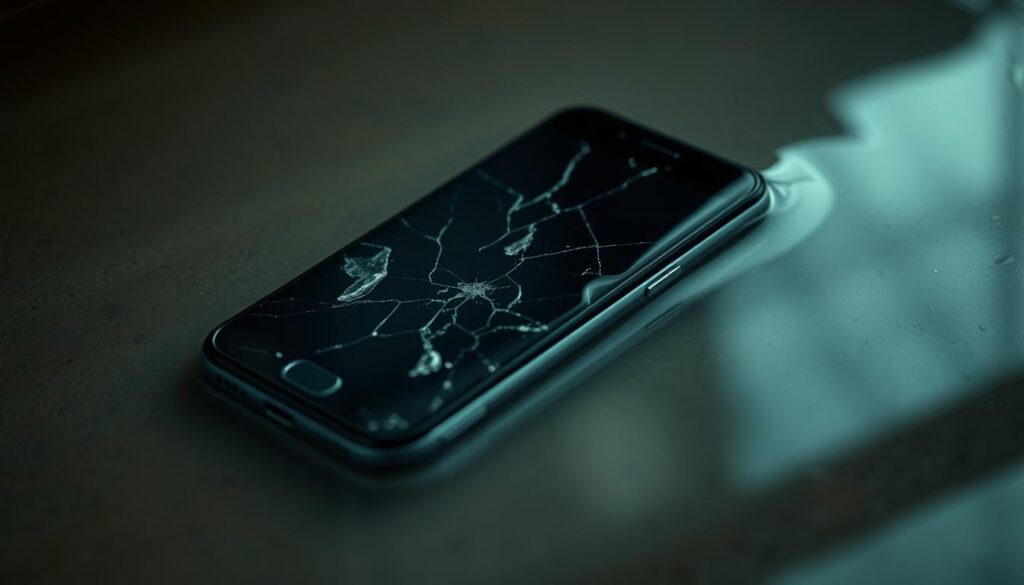
“The biggest risk after water damage is corrosion, which can silently destroy your phone’s internal components over time.”
Waterproofing Options for Future Protection
To keep your device safe from water, look into different waterproofing options. Water damage can ruin your smartphone. Taking steps now can prevent costly repairs and save you from stress.
Waterproof Cases and Covers: A Comparative Analysis
Waterproof cases and covers are a top choice for phone protection. When picking a case, think about the material, thickness, and how it seals. Brands like LifeProof and Catalyst have strong options.
But, it’s key to compare their features. Look at how well they work with touchscreens and charging ports. This helps you find the perfect case for you.
Nano-Coating Services and Their Effectiveness
Nano-coating services add a protective layer to your phone’s inside parts. This method can work well, but its lasting effect and impact on your phone’s performance are important. Companies say it boosts water resistance, but picking a trusted provider is crucial.
Water-Resistant Phone Models Worth Considering
If you’re looking for a new phone, think about water-resistant models. Samsung and Apple make phones with IP67 or IP68 ratings. These ratings mean they can handle water well.
When picking a water-resistant phone, check its specs. Understand its water resistance limits. This helps you make a smart choice.
Insurance and Warranty Considerations
It’s important to know about your insurance and warranty when your phone gets water damage. This info helps you fix or replace your device without spending a lot of money.
Manufacturer Warranty Policies for Water Damage
Every phone maker has its own rules about water damage. It’s key to know these before you make a claim. Usually, regular warranties don’t cover water damage.
Apple’s Approach to Water Damage Claims
Apple’s warranty doesn’t cover water damage. But, if you have AppleCare+, you might get a lower price for accidental damage. This includes water damage. Make sure you know what your AppleCare+ covers.
Samsung and Other Android Manufacturers’ Policies
Samsung and other Android makers also don’t cover water damage with standard warranties. But, they might offer extra insurance or plans for accidental damage, like water. Always check the details of these plans.
Third-Party Insurance Options Worth Considering
If your warranty doesn’t cover water damage, or if you want more protection, look at third-party insurance. Companies like Asurion and SquareTrade offer plans for accidental damage, including water.
- Asurion has full coverage for phones, including water damage, with plans for all needs.
- SquareTrade offers protection plans for accidental damage, like drops and spills, giving device owners peace of mind.
When looking at third-party insurance, read the policy well. Know the coverage limits, deductibles, and what’s not covered. This helps you choose wisely.
Conclusion: Keeping Your Device Safe and Dry
Fixing a water-damaged phone needs quick action and the right steps. Knowing how to get water out of a phone and taking steps to prevent damage can save your device. This way, you can avoid phone water damage.
Drying out a phone is more than just waiting; it’s about careful steps. You need to assess, disassemble, and dry it properly. Using tools like silica gel packets and avoiding heat or charging a wet phone are key.
Being ready with waterproofing and knowing about insurance and warranties can also help. By following these tips, you can lower the risk of water damage. This ensures your phone stays safe and works well.
FAQ
What should I do immediately after dropping my phone in water?
Turn off your phone right away to avoid short circuits. Remove SIM cards, memory cards, cases, and screen protectors. This helps reduce damage.
How does water affect the internal components of my phone?
Water can cause corrosion on your phone’s internal parts. This damage can be permanent if not fixed quickly.
Is the rice method effective for drying out a wet phone?
The rice method is debated for its effectiveness. Better options include silica gel packets or commercial desiccants for drying.
Can I charge my phone after it’s been exposed to water?
No, don’t charge a wet phone until it’s dry. Charging a wet phone can cause more damage due to short circuits.
How can I prevent corrosion after water exposure?
Use isopropyl alcohol on affected parts to prevent corrosion. Choose the right concentration and apply it correctly.
What are the signs that my phone needs professional water damage repair?
Look for signs like your phone won’t turn on, screens don’t respond, or you see corrosion. If you see these, you might need a pro.
How can I test my phone after water extraction to ensure it’s working properly?
Check your phone’s functions like audio, speakers, cameras, and sensors. Watch for any signs of water damage.
What are the long-term effects of water exposure on my phone?
Water can cause corrosion and affect battery performance over time. Keep an eye on your phone’s condition.
Are there any waterproofing options available to protect my phone from future water damage?
Yes, use waterproof cases and covers. Consider nano-coating or choose water-resistant phone models for protection.
Will my phone’s manufacturer warranty cover water damage?
Warranty policies vary by manufacturer. Check your warranty and consider third-party insurance for coverage.
How can I dry out my phone if it has been damaged by saltwater or contaminated liquids?
Flush components with fresh water for saltwater or contaminated liquids. Then, dry them carefully to avoid corrosion.
